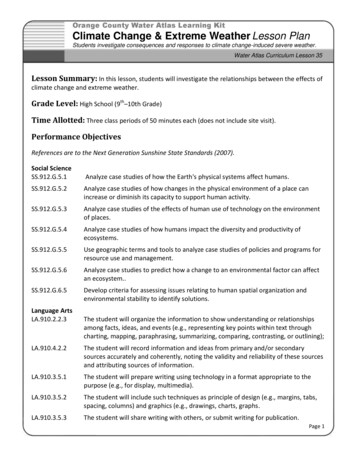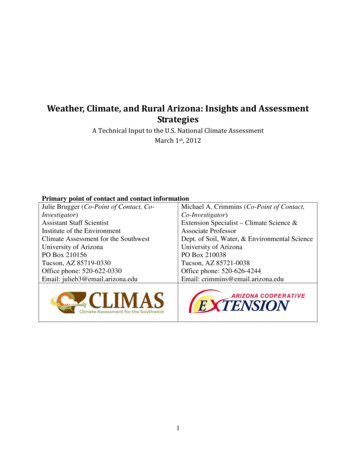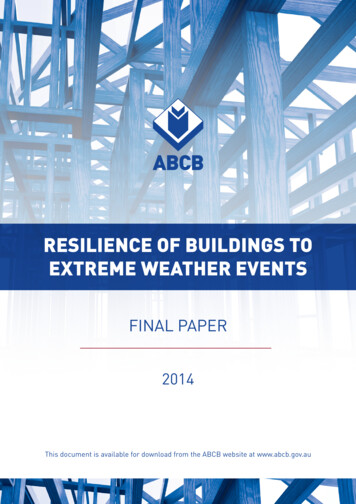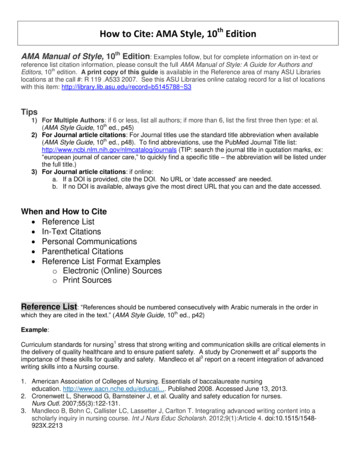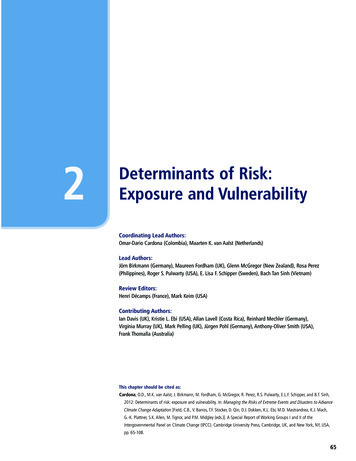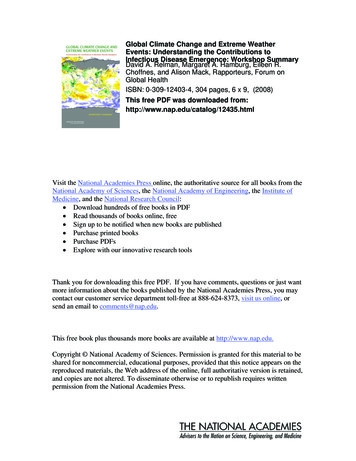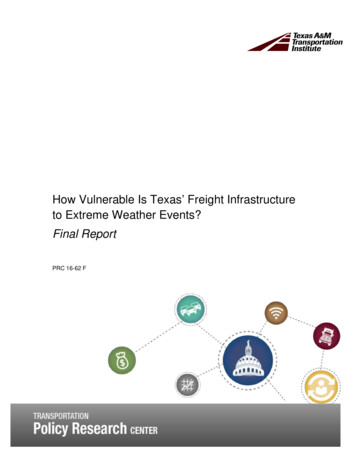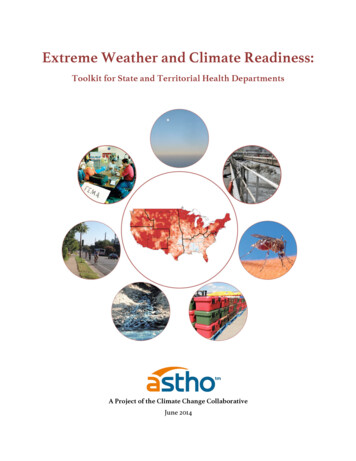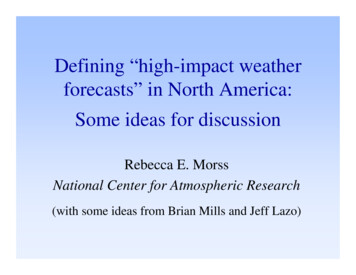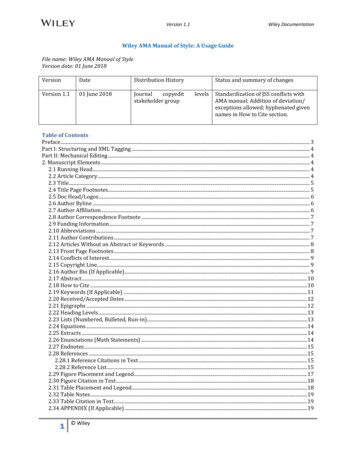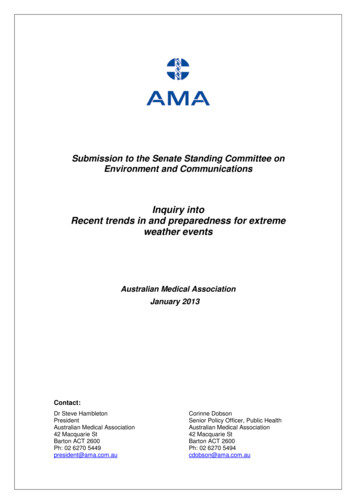
Transcription
Submission to the Senate Standing Committee onEnvironment and CommunicationsInquiry intoRecent trends in and preparedness for extremeweather eventsAustralian Medical AssociationJanuary 2013Contact:Dr Steve HambletonPresidentAustralian Medical Association42 Macquarie StBarton ACT 2600Ph: 02 6270 5449president@ama.com.auCorinne DobsonSenior Policy Officer, Public HealthAustralian Medical Association42 Macquarie StBarton ACT 2600Ph: 02 6270 5494cdobson@ama.com.au
AMA Submission: Inquiry into recent trends in and preparedness for extreme weather eventsIntroductionThe increasing frequency and severity of extreme weather events has significantimplications for public health in Australia. Amid a backdrop of record temperatures,unprecedented heatwaves, and bushfire destruction, the capacity of communitiesand services to respond to climatic extremes is under intense scrutiny. The currentparliamentary inquiry into extreme weather events therefore represents a timely andimportant opportunity to review Australia’s preparedness for such events, includingthe capacity to meet the health impacts of extreme heat, bushfires, flood, severestorms, and drought. As the peak professional organisation representing medicalpractitioners in Australia, the Australian Medical Association (AMA) welcomes theopportunity to make this submission and contribute to the ongoing discussion aroundan important public policy challenge.It is beyond the scope of this submission to quantify the extent and distribution offuture changes to the climate, or to comprehensively address the policy implicationsof weather extremes. This submission focuses instead on the specific healthimplications of extreme weather events, and is framed around the inquiry’s terms ofreference and their specific relevance in terms of health and health services. Itsummarises the key health risks associated with extreme weather events; assessesthe state of preparedness for these risks within and outside the health sector; andrecommends steps needed to improve Australia’s capacity to meet the healthimpacts associated with extreme weather events.Critically, this submission highlights fundamental gaps in Australia’s capacity tominimise and respond to the health impacts of extreme weather events. Whileprogress has been made on some fronts, a number of cross-cutting problemsremain: Government policy is fragmented. Australia still lacks a nationally coordinatedapproach to managing the health impacts associated with extreme weather eventsand climate change. Information on the likely health risks associated with extremeweather events is fragmentary and dispersed, and inhibits effective adaptation atthe local, regional, state and national levels. Policy fragmentation is compoundedby the complexity of interjurisdictional arrangements, and inconsistencies betweenpolicies of different departments within jurisdictions. Lack of understanding of the health implications of extreme weatherevents. Despite growing awareness about the links between climate change andextreme weather events, there is a general lack of understanding of the scope andscale of implications for human health within communities, across the various tiersof government, and within the health sector itself. Information deficits. Information on the likely health risks associated withextreme weather events is fragmentary and dispersed, and this in turn inhibitseffective adaptation at the local, regional, state and national levels. In particular,there is no consistent framework that links health databases with real-timemonitoring and prospective assessment of weather, climate, and geographic data,nor are there a consistent early warning systems. Lack of sustained investment and long-term planning. In most jurisdictions,the focus has been on immediate response arrangements rather than preventativemeasures and longer-term planning (e.g. implementing structural changes thatPage 2 of 13
AMA Submission: Inquiry into recent trends in and preparedness for extreme weather eventswould reduce the impact of future events, or investing in the capacity andresilience of health services in areas at high risk of extreme weather). Lack of supportive regulations, legislation, standards and codes.Failure to sufficiently engage health professionals and health sector in theplanning and preparation for extreme weather events.Despite the challenges posed by climate change and extreme weather events, it isimperative measures are put in place to reduce the health impacts and costs arisingfrom future events. This submission identifies a range of options to achieve this, anddraws upon the AMA’s existing position statements on Climate Change and HumanHealth and The Involvement of GPs in Disaster and Emergency Planning. Theseposition statements are appended to this submission.Page 3 of 13
AMA Submission: Inquiry into recent trends in and preparedness for extreme weather eventsCosts of extreme weather events and impacts on social infrastructureand healthChanges in the frequency, intensity and duration of future weather events will exposegrowing numbers of Australians to hazards that affect their health. Although it isdifficult to precisely quantify the extent and impacts of these changes, it is predictedthat Australia will experience more heat waves, extreme fire weather, severe storms,and drought across southern parts of the continent.1,2,3 Some of the health effectsaccompanying these changes will be direct, such as increases in mortality andmorbidity associated with heat waves. Other health impacts will be indirect, includingdamage to health infrastructure, depression and post-traumatic stress disorder,increasing health inequities, and an erosion of the social determinants of goodhealth. When estimating the overall financial costs associated with extreme weatherevents, it is imperative that consideration is given to the significant costs arising fromhealth impacts.Although the health impacts associated with more prevalent and severe extremeweather events will be profound, these impacts will not be evenly distributed, and aredependent on specific geographic, demographic, health and social contexts. Thegrowing chronic disease burden and population ageing are critical considerations,and will act to magnify the health effects of extreme weather. Current and futuremitigation and adaptation strategies will also determine the extent of localised healthimpacts and the associated costs. Accounts of the health effects of climateinfluenced disasters suggest that a lack of adequate health service planning andsupport is often a necessary (but not sufficient) cause of the health consequences ofsuch events, especially for vulnerable groups.4 This is especially so in rural andregional areas where, as was seen in the case of the 2011 Queensland floods andthe 2009 Victorian bushfires, deaths and injuries are more likely in areas that aremore isolated and lack ready access to emergency services support and centralisedpreparatory planning and risk management services.5Understanding the interaction between these various factors is essential for mappingthe health risks associated with weather extremes, and is a prerequisite for effectiveplanning and preparation and the strategic allocation of resources. Despite thepressing need for such analysis, limited work has been undertaken at a local orregional level to systematically map the health risks and projected costs associatedwith extreme weather. Planning and preparation for these impacts is hampered by alack of localised information that combines projected weather changes with relevanthealth and demographic data.Although the magnitude and distribution of health impacts – and their resulting costs– is yet to be comprehensively determined, a number of studies have documentedthe likely health implications of extreme weather trends and projections in Australia,as summarised below.Extreme heat and bushfiresModelling of future climate change predicts that Australians will face extreme hotweather far more often, with the number of days with temperatures over 35 Cpredicted to double by 2030 for major cities in southern Australia.1,2,3 As well asbecoming more frequent, heatwaves are likely to increase in intensity and duration,Page 4 of 13
AMA Submission: Inquiry into recent trends in and preparedness for extreme weather eventsthereby compounding the adverse consequences of such events.The health implications of these projections are profound. Heatwaves have a greaterimpact on population health in Australia than any other natural hazard, and areassociated with significant increase in mortality and morbidity rates.6 Figure 1 depictsthe estimated increase in mortality associated with extreme heat events, andcompares rates for 2011, 2030 and 2050.* As this figure reveals, deaths associatedwith extreme heat are predicted to more than double if Australia does not improve theway these events are smaniaHeat-related deaths201120302050Figure 1. Estimates of extreme heat-related deaths for 2011, 2030 and 2050(adapted from 2011 PricewaterhouseCoopers Report, ‘Protecting human health and safety during severe andextreme heat events’8)Extreme heat events have been linked to increased GP visitations, ambulancecallouts, presentations to emergency departments, and hospital admissions forconditions relating to heat stress and dehydration, or as a result of heat exacerbatingpre-existing conditions.9 The risk of heat-related mortality and morbidity is increasedfor people with pre-existing illnesses, including cardiovascular disease; psychiatric,neurological and cognitive impairment; diabetes, cancer and obesity.10 Somemedications used to increase these conditions may also increase vulnerability toheat-related health effects by compromising thermoregulation, thermal awareness,mobility, or the ability to adopt protective behaviours. An additional area of concern isoccupational heat stroke, particularly for outdoor workers and indoor workers withminimal access to cooling systems while working.11*Based on modelling that incorporates relevant climate data, health data, and population data and projections.Page 5 of 13
AMA Submission: Inquiry into recent trends in and preparedness for extreme weather eventsBushfiresA particular risk in hot weather in Australia is bush fires and related health risks fromsmoke and burns. In addition to large scale loss of life and injury, the effects ofincreased air pollution can impact on respiratory disease among populations that arenot directly affected by fire. Bushfire can damage local infrastructure, lead to thecontamination of water supplies, and disrupt the delivery of health services. Longterm health consequences include post-traumatic stress, depression and anxiety.12Wind, storms and floodsThe health costs arising from extreme wind, storm and flood events are significant,and can stem from short-term (e.g. drowning and physical trauma), medium-term(e.g. spread of infectious and vectorborne diseases), or long-term (e.g. posttraumatic stress and depression).12 Such events cause significant damage toinfrastructure, thereby hindering the delivery of health services both during and afterof such events. Damage to water supplies and sewerage treatment facilities cancontribute to contaminated water and facilitate the spread of infectious disease.DroughtDrought can indirectly contribute to health risks by reducing the supply and quality ofwater and food, increasing the probability of bushfires, and creating an environmentconducive to the spread of vectorborne diseases.12 The potential mental healtheffects of drought are significant, particularly among rural communities. Prolongeddrought may also affect the cost and availability of food, leading to dietary changesand intensifying cost of living pressures for people on low incomes.Vulnerable populationsThere is a growing recognition that the distribution of weather-related health impactshas been, and will continue to be, uneven, falling more heavily on low-incomepopulations and those with chronic health conditions. Other factors associated withincreased vulnerability include age, disability, homelessness, social isolation, poorEnglish language skills, and residing in rural and remote communities. Vulnerabilityto health impacts is considered to be particularly elevated for Indigenous peopleliving in remote communities.Identifying populations or regions where vulnerability is particularly high can help toquantify the potential costs associated with extreme weather, and to clarify whereefforts to increase the adaptive capacity should be focused. Such analysis, however,is limited in Australia, particularly at a localised level. Despite acceptance that thehealth impacts and costs arising from extreme weather events will be unevenlydistributed, limited research has been undertaken to more precisely estimate thesedifferential impacts, nor has systematic modelling been undertaken to furnish localgovernments with the data and information they require to identify areas ofheightened vulnerability.13,14 It is imperative such knowledge and information gapsare addressed if we are to better understand the potential health-related costs arisingfrom future weather events, and to develop strategies to minimise these costs.Page 6 of 13
AMA Submission: Inquiry into recent trends in and preparedness for extreme weather eventsRecommendation: A systematic analysis of the health costs associated withincreased weather events is yet to be undertaken in Australia, and it is imperativethat there is a better understanding of the full extent of potential health impacts.Quantitative modelling of the health impacts and costs associated with extremeweather events should be undertaken, including identification of highlyvulnerable groups and regions. In conjunction with this, local governmentsshould be equipped with the support tools and relevant data and informationrequired to undertake local health impact assessments and vulnerabilitymapping.Recommendation: Future estimates of the economic impact of extreme weatherevents should incorporate costs associated with the widespread health effects ofsuch events.Preparedness of key sectors for extreme weather eventsAustralia is ill-prepared to deal with the health impacts of increasingly frequent andintense extreme weather events. This preparedness gap includes not justinfrastructure and capacity, but also limitations in knowledge and awareness, in theavailability of reliable decision support tools, and in mechanisms for coordinating theefforts of different sectors and various tiers of government. The health impacts ofextreme weather will intensify the demand and strain on health services, and amplifyexisting disorders and health inequities. Critically, however, mitigation andpreparatory activities for these health impacts need to take place within both thehealth and non-health sectors. Extreme heat events, for example, can place strain onelectricity supply networks, resulting in outages that not only limit access to airconditioned environments and increase the incidence of heat stress, but alsointerfere with the operation of health services.Addressing information and knowledge deficitsA sound understanding of the health impacts and implications of extreme weather isvital to mobilise action and ensure communities, services, and local governments areadequately prepared. There is, however, limited understanding – both within andoutside the health sector – about the risks to health from extreme weather andclimate change. As the preceding discussion has indicated, information on the likelyhealth costs associated with extreme weather events is fragmentary and dispersed,and this inhibits effective adaptation and planning across a range of sectors andsettings. At present, there is no consistent framework that links health datasets withreal-time monitoring and prospective assessments of weather, climate andgeographic data. This not only prevents health services from receiving timelyinformation, but also limits the capacity of other sectors to factor relevant healthconsiderations into planning and preparation.To motivate appropriate responses across all sectors of society, further research isrequired to identify how to communicate most effectively the health risks associatedwith extreme weather, and the possible health benefits of mitigation and adaptationoptions to address these risks.Recommendation: It is imperative greater efforts are made to communicate to thepublic, and to policy makers, the health threats posed by extreme weather events.Page 7 of 13
AMA Submission: Inquiry into recent trends in and preparedness for extreme weather eventsRecommendation: To inform future communication strategies that raiseawareness of weather-related health impacts, a comprehensive evaluation shouldbe undertaken of existing risk communications, and research should beundertaken to identify effective messaging, modes of delivery, and specificcommunication strategies targeting vulnerable populations.Developing standardised and effective early warning systemsEvidence demonstrates that early warning systems can reduce the morbidity andmortality associated with extreme weather events.15 Accurate and timely alertsystems are therefore critical for managing and minimising the health impactsassociated with extreme weather events. To be effective, early warning systemsneed to be communicated in a timely and relevant manner to services, and shouldform an integral part of the operational decision-making process in the health sector.For example, emergency departments in hospitals need to be alerted in time tomanage an increase in admissions associated with heat waves or other extremeweather events. Community and service providers also need to be equipped to takethe appropriate course of action and preventative measures if warnings are issued.Despite the demonstrated importance of early warning systems, there are significantgaps and inconsistencies in early warning systems across Australia. Effective earlywarning systems should initiate a range of interventions in response to a warning.However, of those warning systems that are currently in place in Australia, few havebeen evaluated for their effectiveness. In addition, greater efforts need to be made toinclude input from the health sector and health professionals to ensure early warningsystems incorporate relevant information and are communicated appropriately. Thismay include, for example, understanding the temperature thresholds for issuingwarnings associated with extreme heat, and identifying preventative health andprotective actions that need to be initiated when such alerts are issued.Recommendation: Early warning systems need to be maintained andstrengthened to improve the capacity of services and communities to respond toextreme weather events.Improving the preparedness of the health sectorExtreme weather events pose numerous challenges to health services, and it isimperative a more sustained and coordinated response is developed to better equipthe health sector for future events. Simultaneous or successive weather events havethe potential to place an enormous strain on health resources, yet, in general, thehealth sector is ill-prepared for the potential demands that may arise from suchevents.One of the fundamental issues that has undermined preparedness across the healthsector is a gap in policy leadership at the federal level and from the federal healthbureaucracy. In 2007, COAG identified the need for a national strategy specificallydesigned to drive and coordinate actions to reduce the health impacts of climatechange and climate-related events. Despite the recognised need for this coordinatedand strategic response, policies to support the preparedness of the health sector areyet to be put in place, and the existing National Environmental Health Strategy doesnot fulfil this purpose. The AMA believe that a National Strategy for Health andClimate Change should be urgently developed. This strategy should in turn underpinPage 8 of 13
AMA Submission: Inquiry into recent trends in and preparedness for extreme weather eventsfuture efforts to improve the capacity of the health sector to respond to thechallenges posed by extreme weather events.In addition to policy leadership, there are a range of factors that can compromise thepreparedness of the health sector, including: lack of long-term planning to improve the resilience of services; limited understanding of the risks to health from extreme weather events; lack of relevant and accessible information on trends and likely impacts to informfuture planning and strategic allocation of resources; insufficient surge capacity for responses to extreme weather events andincreased health care demand; lack of accurate and timely alert systems; and,failure to adequately engage the health sector and health professionals inmitigation/adaptation strategies and local disaster management plans.Extreme weather events have the potential to amplify the effects of chronic diseaseand, in the context of population ageing and the increased incidence of extremeweather, health service planning needs to incorporate the potential healthcaredemands that may arise.16 Despite the synergistic effects of increasing chronicdisease and more extreme weather, limited attention has been given to integratingclimate and weather-related factors into the current health policy and planning.An increase in the frequency and intensity of extreme weather has the potential tomagnify health inequities, and exacerbate the strain on health services in rural andremote regions.17 Greater efforts are required to boost the capacity and resilience ofhealth services in areas with a heightened vulnerability, including rural and remoteareas, and in remote Indigenous communities.Preparing the health sector for future extreme weather events requires a thoroughunderstanding of the potential health risks, areas likely to experience pronouncedincreases in service demand, the possible impacts on infrastructure, and whatconstitutes effective strategies to protect health in the context of such events. Healthprofessionals are ideally placed to identify the ways in which extreme weather eventsmay impact on people’s health, and to communicate this to the public and to policymakers. Within the health sector, however, knowledge and awareness around thehealth impacts of climate change and extreme weather events is variable. Increasingawareness among health professionals could assist in developing more effectiveresponses, as well as facilitate communication with the public about the risk to healthand preventative or health protection strategies. Moreover, greater awarenessamong public health bureaucrats and policy makers is imperative if relevantconsiderations are to be factored into policy and planning processes.Recommendation: A National Strategy for Health and Climate Change should bedeveloped and implemented to ensure Australia can respond effectively to thehealth impacts of climate change and extreme weather events, and to improve thepreparedness of the health sector.Recommendation: A communication strategy for the health sector should bedeveloped and implemented to raise the level of knowledge and awareness ofclimate- and weather-related health risks. Increasing awareness among healthprofessionals is necessary to develop more effective adaptive responses, and toPage 9 of 13
AMA Submission: Inquiry into recent trends in and preparedness for extreme weather eventssupport better communication with the public about risks to health and effectivestrategies for health protection. Funding should be made available for thedevelopment and delivery of quality professional development for health andother community services personnel on the health impacts of climate change andextreme weather events.Recommendation: Improve existing public health surveillance systems to ensurethey are sufficiently comprehensive and sensitive to monitor the effects ofclimate change and extreme weather on health morbidity and mortality.Recommendation: When designing and implementing health impact assessmentsand vulnerability mapping associated with extreme weather, ensure input issought from health professionals and the health sector. Ensure the outcomes ofthese assessments and mapping are incorporated into future planning andpreparedness strategies for health services.Improving coordination and intersectoral linkagesRecommendation: Strong and active communication linkages between hospitals,major medical centres and local weather forecasters and emergency responseagencies should be maintained to maximise timely response and efficient use ofhealth resource in extreme weather events.Preparedness and adequacy of resources in the emergency servicesto prevent and respond to extreme weather eventsGiven the projected increases in extreme weather events, and the increasedlikelihood of simultaneous or successive events, greater attention needs to be givento the preparedness and adequacy of emergency services and the resultantpressures in emergency and high acuity health services. Ensuring emergencyservices are appropriately coordinated with health professionals, medical centres,clinics, hospitals and other health care facilities is critical to manage increaseddemand and the infrastructure disruptions that may accompany major emergencies.The AMA’s position statement Involvement of GPs in Disaster and EmergencyPlanning outlines key considerations that should inform emergency planning, and isappended to this submission. As this statement indicates, planning for GPinvolvement at the time of disasters has been ad hoc and variable acrossjurisdictions, and improved coordination and communication mechanisms arerequired to better utilise primary care practitioners during extreme weather events.Recommendation: The input of medical practitioners, including GPs, should beincorporated in emergency response planning, and as part of response teams,across all jurisdictional layers.Recommendation: Emergency services and local emergency response plansshould maintain databases to record primary care practitioners who have theappropriate training and are willing to participate in medical response teams, orto assist in delivering medical services during extreme weather events.Page 10 of 13
AMA Submission: Inquiry into recent trends in and preparedness for extreme weather eventsRecommendation: Coordinated planning and policy procedures need to beestablished in high-risk regions to manage climate-related contingencies and‘surge capacity’ demands. This includes improved communication mechanismsbetween emergency services and primary health care providers; strategies toupscale emergency and high acuity health services as needed; and ensuringessential infrastructure, hospitals and other services are designed to withstandthreats to energy supply (e.g. during heatwaves) and direct climatic impacts (e.g.coastal inundation).National coordination of climate change response and riskmanagementDespite the profound health risks posed by climate change and extreme weatherevents, the response to these risks has been characterised by a lack of nationalcoordination and policy leadership. In 2007, COAG committed to developing anational strategy specific to health as part of the National Climate Change AdaptationFramework. This Framework, however, is yet to be developed.Planning for the impacts of climate change and extreme weather requires effortsbeyond any single agency or portfolio, and greater efforts are required to achieve awhole-of-government approach and better coordination across agencies andportfolios, and across different tiers of government. For example, the last riskassessment by the Commonwealth Department of Health an Ageing was undertakenin 2002, and the department is yet to develop resources on health adaptation ormitigation strategies in response to extreme weather events or climate change, eitherfor health professionals or for the public.Political will to address the health risks of extreme weather events is essential. Thisincludes developing strategic policy frameworks, implementing adaptation plans, andensuring effective monitoring and management. It is also necessary to buildcoalitions between relevant sectors and partners, and to encourage publicunderstanding and support. Greater national consistency is also required in keyelements underpinning planning and response arrangements. This includesdeveloping consist methodologies for forecasting heat events and triggering publichealth warnings. At present, there is no nationally agreed definition of whatconstitutes a heat wave or heat event.Recommendation: A national heat event strategy should be developed andmaintained, complimenting the National Strategy for Disaster Resilience, and withappropriate consideration given to the significant health implications and healthservice demands associated with extreme heat.Gaps in Australia’s Climate Change Adaptation FrameworkTo improve policy coordination and leadership, there is a need to refresh the NationalClimate Change Adaptation Framework. Aside from research efforts, there has beenlittle visible progress on this framework, which was agreed by COAG in 2007.As it is currently articulated, the national framework perpetuates the silo mentalitythat demarcates policy into discrete areas, and provided little impetus for the wholeof-government response needed to respond to climate change. Health is notintegrated across the strategy, but is instead sequestered in a discrete section of thePage 11 of 13
AMA Submission: Inquiry into recent trends in and preparedness for extreme weather eventsdocument. It is critical a refreshed national framework supports improvedcommunication and joint planning between portfolios, including health and ageing,environment, and
extreme weather events, there is a general lack of understanding of the scope and . state and national levels. In particular, there is no consistent framework that links health databases with real-time monitoring and prospective assessment of weather, climate, and geographic
